
I posted previously about Jim Riley and the sweaters he has knitted, with smaller posts about his rude sweaters and Sweaters of Adoration for the Chelsea Football Club.
Here I show you more of the art and quirk in his house. There are two collections in the house that are in the sphere of control of his wife Linda.

Obviously – souvenir spoons.

Obviously, salt and pepper shakes. Linda’s parents passed them on to her. The former ironing board cubby is the perfect display venue for them.


Riley collects Chelsea stuff which I have shown, and he collects duck mugs.


His major collection these days is his collection of toy red London buses. They are displayed on the second story of his studio on Hearst Avenue.
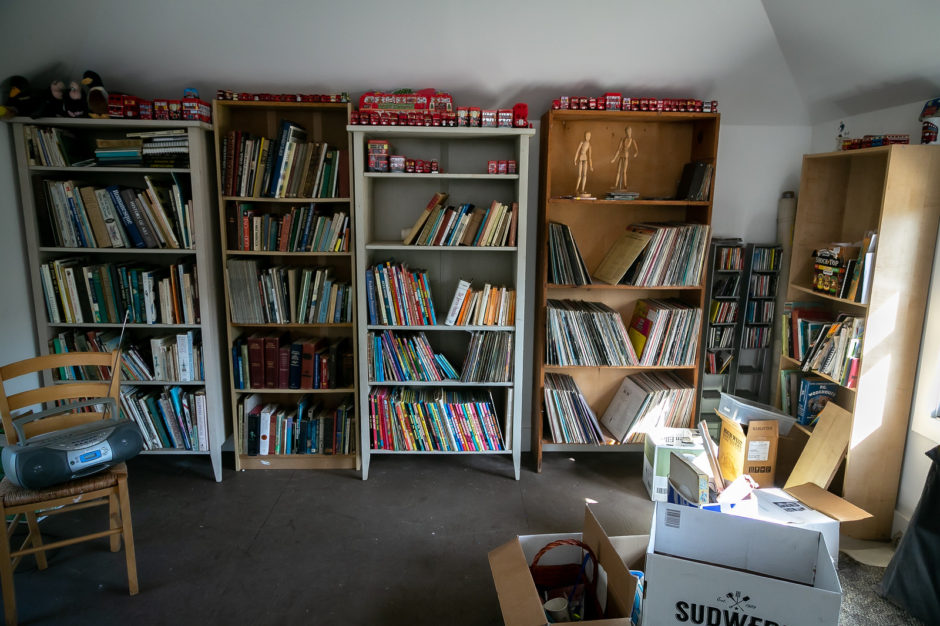
In the art-imitating-life department, the juxtaposition of the red buses and the articulated wooden figures on the top right shelf inspired a painting of a dart boatd cabinet.
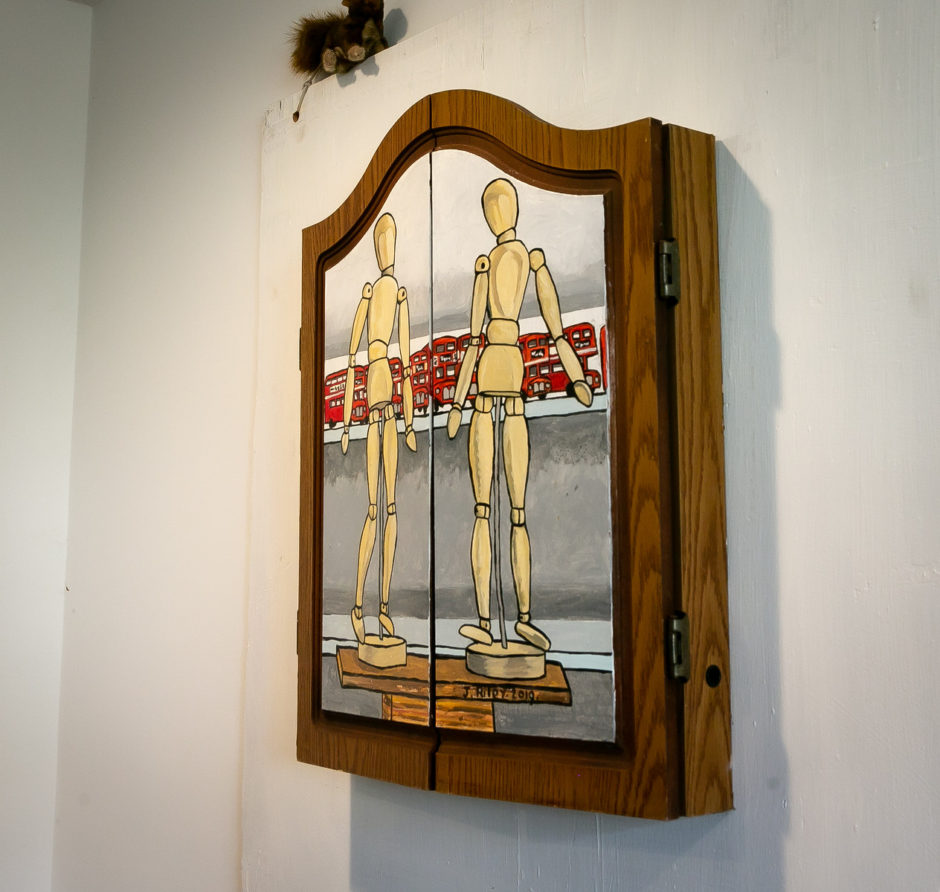
Back to the bus collection. The small buses are Matchbox toys, a popular British toy brand which was introduced by Lesney Products in 1953The medium-sized die-cast toy buses were made Corgi Toys (trademark). The larger ones were tea tins. Riley collected these the old-fashioned, hard way, one at a time in thrift stores, junk stores, and garage sales – no internet machine for Jim Riley in his quest.

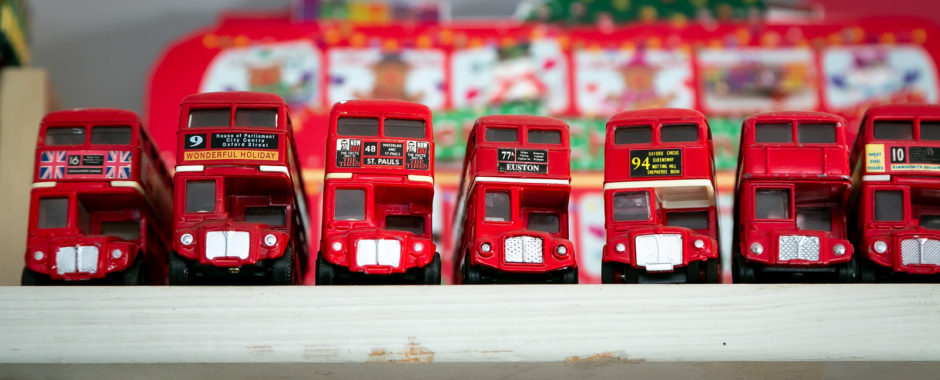




That, my quirk-loving friend, is a fine collection.
Moving now into things that Riley has made.

He paints saws.

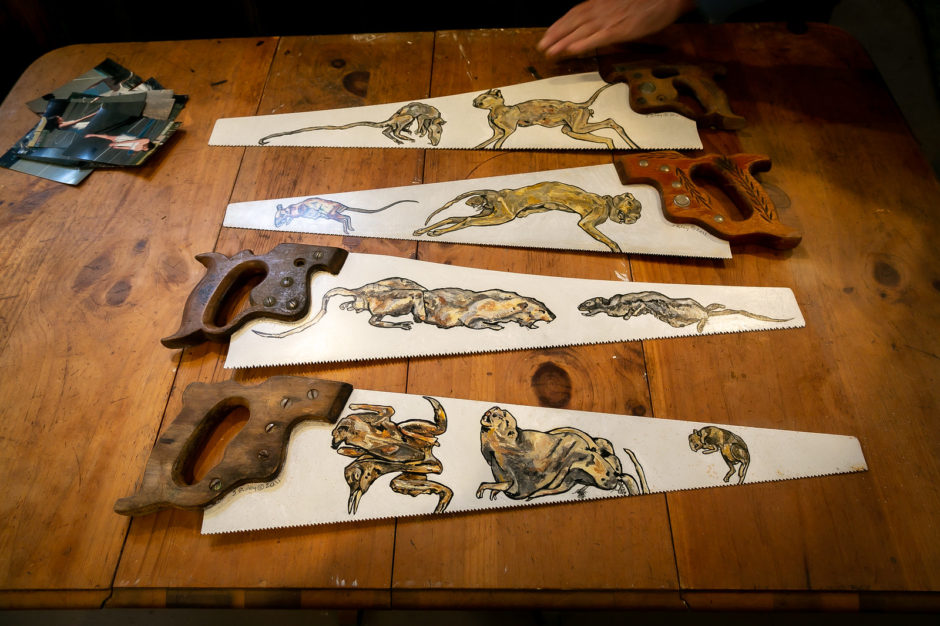
For a while Riley saved dead animals. They are celebrated in these saw paintings.
Riley collects old saws

He is ready for when the urge strikes..


Each year Riley paints palate for his daughter Ruby’s birthday. I think we are up to 17. Maybe 16.
Riley’s first love in making art was sculpture. There are several of his pieces in his home and the yard.

Riley used a women working for his wife in one of her bars as the model for this sculpture. In the previous post you saw his rendition of this sculpture on a sweater.


This is Rudy, a dog from Jim’s past;
There are several sculptures in the back yard. The lead photo of this post shows me pointing one out.


Riley showed me a photo of a chess set that he made for his brother in Petaluma.

The set pits (pun!) fruits, vegetables and animals against ancient Romans, horses, and airplanes. Awesome!


At his studio on Hearst, Riley is working on a sculpture of daughter Ruby holding a dog on a leash – leash and dog to follow. Now that he is retired and has some time available or a sculpture project, he hopes to make a life-size rendition of Ruby and dog.

Riley made this aluminum sculpture in Oregon. It represents his hope for a relationship with a beautiful woman, a child, and yet the freedom represented by the skateboard. I feel the power of this piece.
Now, paintings. These are but a few of his many paintings.






This painting absolutely blows me away.

As does this one. Very powerful for me.


Riley made this painting for a fellow bus driver who was retiring – an articulated bus, a fox fur (an allusion to a passenger) and a Tasmanian Devil.

The Tasmanian Devil sarcophilus harrisii) is a carnivorous marsupial, It was once native to mainland Australia and is now found in the wild only on the island state of Tasmania. Depicted in the painting is the Looney Tunes version, named Taz. Taz is generally portrayed as a ferocious, albeit dim-witted, carnivore with a notoriously short temper and little patience. Taz appeared in only five shorts before Warner Bros. Cartoons closed down in 1964, but his appeal is disproportionate to that short run.

Riley paints these days in his studio behind a house that he and Linda own on Hearst Avenue.


The paintings living in the studio are for the most part from a while ago.

A drawing made with pastel chalk.

Another chalk pastel.

This is Riley’s 1981 R80GS BMW. A total of 21,864 were manufactured between 1980 to 1987. It is often considered the world’s first “Adventure Bike” able to be equally capable on and off-road.


This painting depicts the Emeryville City Hall, not far from where Riley lived in West Oakland.



Riley once had a significant toy tractor collection, shown in these paintings. The collection dispersed, he thinks, to nephews.
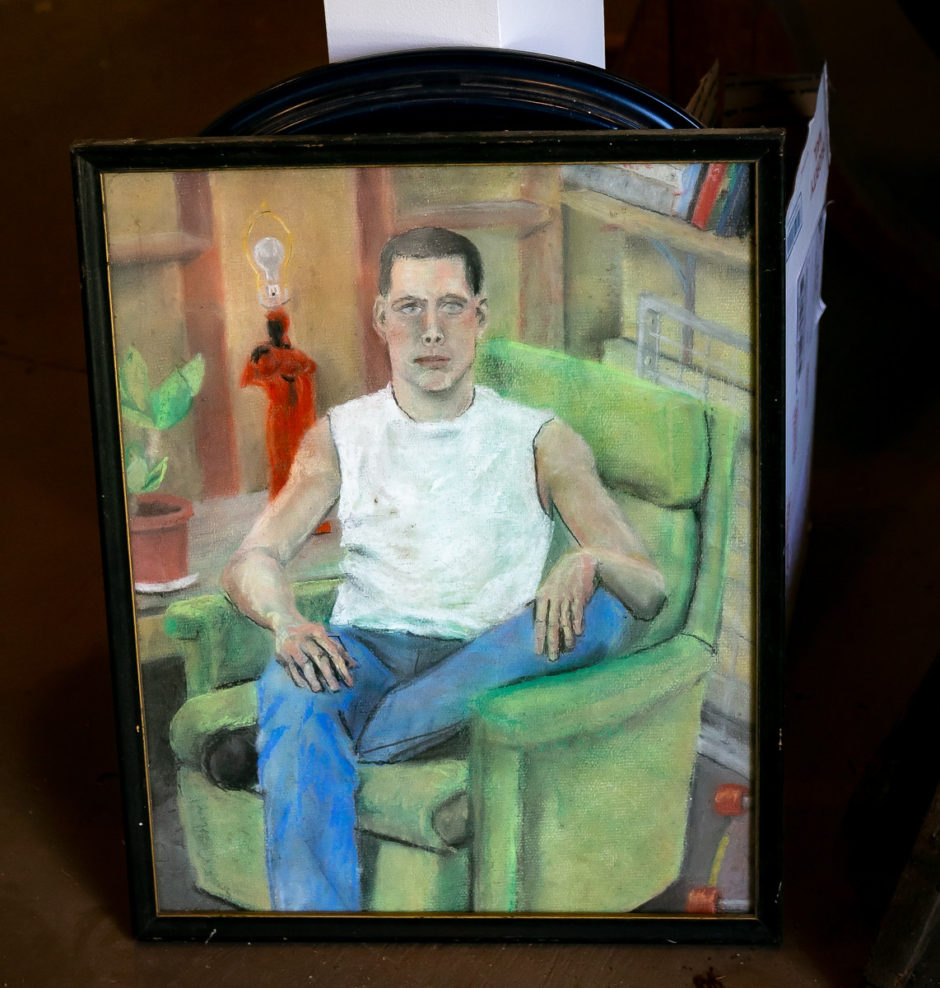
A self-portrait in pastel, dated 1980.
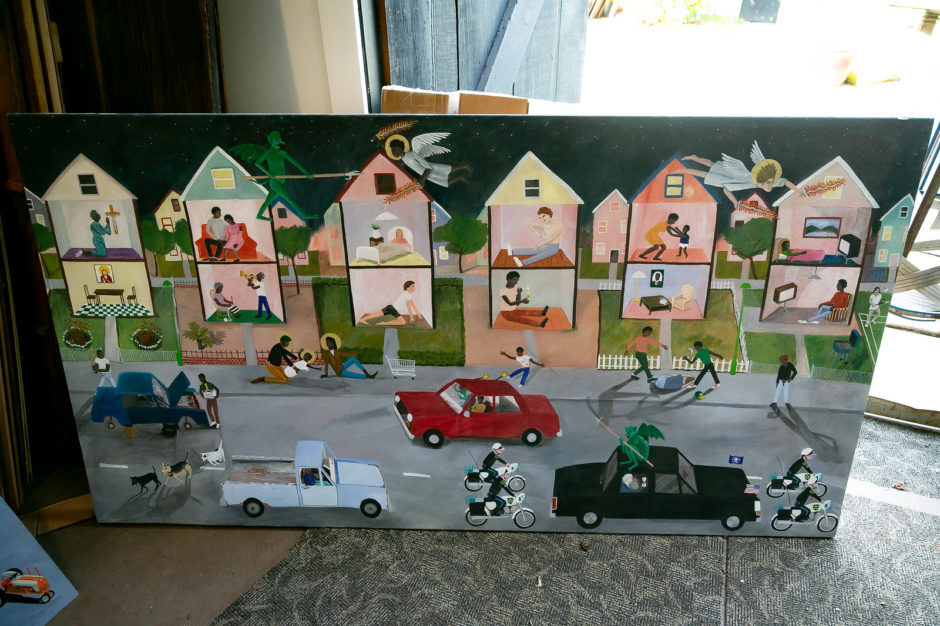
The beauty, joy, and horror of life in West Oakland. All is welling many homes, but thieves are sealing car batteries and an addict is shooting up.

A painting from 1987 – woman and man, could be dream lover of a lifetime.

From the late 1980s. Again, dream love, dream lover. Two dogs.

This is one of Riley’s most personal paintings. His first wife, a German, left him after getting immigration papers, a car, and a son. He was angry and he vented in this painting He isn’t angry now.

I am reminded of Bob Dylan’s 1964 “Ballad in Plain D.” Dylan sings about the final traumatic night of his romance with Suze Rotolo, shown above. He wrote: “For her parasite sister I had no respect / Bound by her boredom her pride to protect.”
So it was with Riley and his feelings of rejection.

This was Riley’s 1989 Triumph Speed Triple. The Triumph Triples are a family of modern three-cylinder motorcycle engines made from 1990 onwards by the Triumph Motorcycle Company at their Hinckley, Leicestershire factory. The inspiration for the later triples was the pushrod Triumph Trident, produced from 1968 to 1974 at the Triumph factory at Meriden Works.

This is Riley’s 1975 R75/5 BMW, his first real motorcycle after years of riding motor scooters. The BMW R75/5 was a boxer twin motorcycle manufactured in Berlin by BMW, featuring electric starting and telescopic forks.

Another painting from the 1980s in which Riley was anticipating the day when he had a partner.
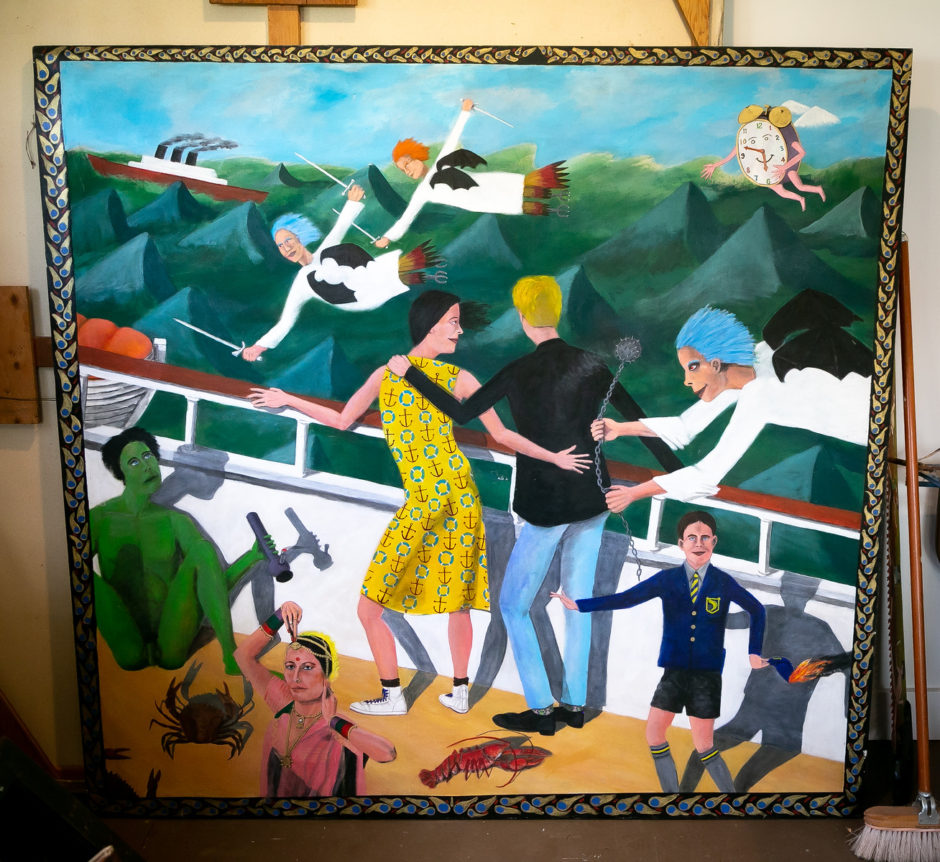
Young Jim Riley from his John Fisher School days is in the lower right. Another exploration of dream love with dream lover.

A barbecue, as angels bring Jim and his wife a baby. The German airplanes reflect her national origin.

A dystopian political painting that Riley made in 1989.

This painting is from 1990. The brown dog is Rudy. The white dog is Sally.
Thus endeth the paintings.
There is a final photo that John Storey made at Riley’s studio.

A trout and a duck. Two icons that recur in much of Riley’s art – his sweaters, his paintings, his collections.
Riley is not in the business of selling paintings. He makes them and then makes another one. It is art and it is his life. “Art for art’s sake” is the usual English rendering of a French slogan from the early 19th century, “l’art pour l’art“, and expresses a philosophy that the intrinsic value of art, and the only “true” art, is divorced from any didactic, moral, politic, or utilitarian function. That would be the art of Jim Riiley.
Still to come, perhaps as early as next week, is a story of Riley’s life, the long and winding road that brought him to Berkeley, the only place he could really ever be.
When I asked my friend to come and look at this draft, he brought with him six photos that he handed me.






He was tripping big-time over this 1940 three-dimensional model of San Francisco, described here. Parts of the model are on view The Main Library and all branch libraries, plus a temporary branch at the San Francisco Museum of Modern Art.

Each will get the portion that pertains to their area. He plans to visit each and every branch over a two-day period next week, driving a borrowed 1964 Ford Mustang with its original price sticker of $2,368.
I applauded his project and asked what he thought of this post about Jim Riley’s collections and art. His answer:


